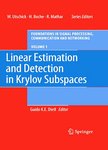版权所有:内蒙古大学图书馆 技术提供:维普资讯• 智图
内蒙古自治区呼和浩特市赛罕区大学西街235号 邮编: 010021

丛 书 名:Foundations in Signal Processing, Communications and Networking
版本说明:1
I S B N:(纸本) 9783540684787;9783642088032
出 版 社:Springer Berlin Heidelberg
出 版 年:2007年
页 数:XX, 232页
主 题 词:Electronics and Microelectronics, Instrumentation Signal, Image and Speech Processing Computational Science and Engineering Statistics for Engineering, Physics, Computer Science, Chemistry and Earth Sciences Math Applications in Computer Science Mathematical and Computational Engineering
学科分类:0711[理学-系统科学] 07[理学] 08[工学] 080401[工学-精密仪器及机械] 0804[工学-仪器科学与技术] 080402[工学-测试计量技术及仪器]
摘 要:One major area in the theory of statistical signal processing is reduced-rank - timation where optimal linear estimators are approximated in low-dimensional subspaces, e.g., in order to reduce the noise in overmodeled problems, - hance the performance in case of estimated statistics, and/or save compu- tional complexity in the design of the estimator which requires the solution of linear equation systems. This book provides a comprehensive overview over reduced-rank ?lters where the main emphasis is put on matrix-valued ?lters whose design requires the solution of linear systems with multiple right-hand sides. In particular, the multistage matrix Wiener ?lter, i.e., a reduced-rank Wiener ?lter based on the multistage decomposition, is derived in its most general form. In numerical mathematics, iterative block Krylov methods are very po- lar techniques for solving systems of linear equations with multiple right-hand sides, especially if the systems are large and sparse. Besides presenting a - tailed overview of the most important block Krylov methods in Chapter 3, which may also serve as an introduction to the topic, their connection to the multistage matrix Wiener ?lter is revealed in this book. Especially, the reader will learn the restrictions of the multistage matrix Wiener ?lter which are necessary in order to end up in a block Krylov method. This relationship is of great theoretical importance because it connects two di?erent ?elds of mathematics, viz., statistical signal processing and numerical linear algebra.